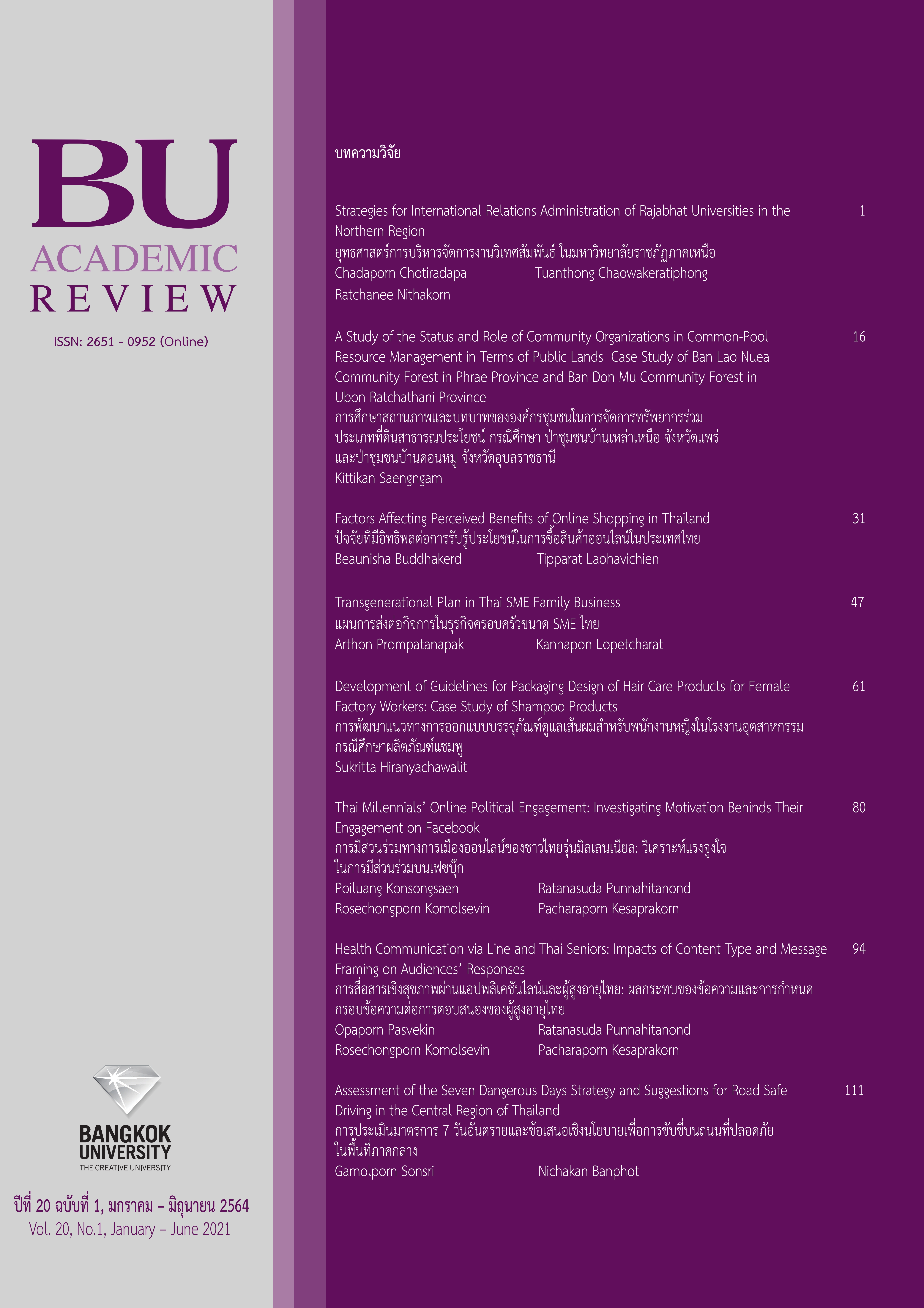แผนการส่งต่อกิจการในธุรกิจครอบครัวขนาด SME ไทย
Main Article Content
บทคัดย่อ
ธุรกิจครอบครัวมีความสำคัญในการขับเคลื่อนเศรษฐกิจไทยในอัตราร้อยละ 72.00 ของประเทศ (มูลค่าประมาณ 39 ล้านล้านบาท) วัตถุประสงค์งานวิจัยนี้คือการศึกษาการเตรียมพร้อมในการส่งต่อกิจการธุรกิจครอบครัวขนาดกลางและขนาดเล็กของไทย และการเตรียมพร้อมในการสืบทอดกิจการของรุ่นต่อไป โดยผู้ประกอบการส่วนใหญ่มีความยากลำบากในการวางแผนการสืบทอดกิจการอย่างมั่นคง งานวิจัยนี้ได้สัมภาษณ์เชิงลึก เจ้าของธุรกิจครอบครัว จำนวน 100 ราย ผลการวิจัยพบว่าผู้ประกอบการส่วนใหญ่มีแผนการส่งต่อธุรกิจแก่ทายาทรุ่นต่อไป โดยเจ้าของกิจการรุ่นที่หนึ่งมักมีความหลงใหลในธุรกิจที่ตนเองเป็นผู้สร้างและต้องการจะส่งต่อกิจการอันเป็นมรดกนี้แก่ทายาทรุ่นต่อไป และเจ้าของธุรกิจรุ่นที่สองต้องการส่งมอบความมั่นคงและกิจการที่ทำกำไรแก่ทายาท แต่ผู้สืบทอดธุรกิจครอบครัวรุ่นที่สามอาจจะไม่ต้องการที่จะรับมอบกิจการต่อจากพ่อแม่ เนื่องจากได้รับอิสรภาพในการบริหารงานน้อย และผู้สืบทอดฯ รุ่นที่สามมีความหวงแหนในกิจการน้อยกว่าเจ้าของกิจการรุ่นก่อน งานวิจัยนี้ยังพบสิ่งที่ไม่สอดคล้องกันระหว่างเจ้าของกิจการทั้งสามรุ่น คือ ผู้ประกอบการรุ่นเก่ามีความคาดหวังในการศึกษาที่สูงขึ้นของทายาทรุ่นใหม่ที่ไม่ตรงกับความต้องการของตน, ความมีฉันทะและความรับผิดชอบต่อกิจการที่ไม่เท่ากันระหว่างรุ่น, และการยอมรับในการเปลี่ยนแปลงในแต่ละรุ่นที่ไม่เท่ากัน งานวิจัยนี้แนะนำว่าการวางแผนสืบทอดกิจการอย่างเป็นทางการและการสื่อสารระหว่างรุ่นจะเป็นสิ่งที่ช่วยในทายาทสามารถนำความคิดสร้างสรรค์และเทคโนโลยีที่ทันสมัยมาปรับใช้กับธุรกิจครอบครัว และในเวลาเดียวกันทายาทยังได้เรียนรู้ทักษะการเปลี่ยนแปลงองค์กรเพื่อการเปลี่ยนแปลงอย่างราบรื่นในอนาคต
Article Details
บทความที่นำมาสมัครลงตีพิมพ์ในวารสารต้องไม่เคยได้รับการตีพิมพ์เผยแพร่มาก่อน และไม่ส่งต้นฉบับบทความซ้ำซ้อนกับวารสารอื่น รวมทั้งผู้เขียนบทความต้องไม่ละเมิดหรือคัดลอกผลงานของผู้อื่น
เอกสารอ้างอิง
Basco, R., Calabrò, A., & Campopiano, G. (2019). Transgenerational entrepreneurship around the world: Implications for family business research and practice. Journal of Family Business Strategy, 10(4), 1-16.
Bjørnholt, M., & Farstad, G. R. (2012). 'Am I rambling?' on the advantages of interviewing couples together. Qualitative Research, 14(1), 3–19.
Bolton, D. L., & Lane, M. D. (2012). Individual entrepreneurial orientation: Development of a measurement instrument. Education+ Training. 54(2-3), 219-233.
Borgatti, S. P., Everett, M. G., & Freeman, L. C. (2002). Ucinet for windows: Software for social network analysis. Harvard, MA: Analytic Technologies.
Calabròalfredo, A., & Valentino, A. (2019). STEP 2019 global family business survey: The impact of changing demographics on family business succession planning and governance. Babson Park, MA: Babson College.
Cano-Rubio, M., Fuentes-Lombardo, G., & Vallejo-Martos, M. C. (2017). Influence of the lack of a standard definition of “family business” on research into their international strategies. European Research on Management and Business Economics, 23(3), 132-146.
Charupongsopon, W., & Puriwat, W. (2017). The influence of entrepreneurial orientation and family business’s resources and capabilities on marketing performances. European Research Studies Journal, 20(2), 150-163.
Clinton, E., McAdam, M., & Gamble, J. R. (2018). Transgenerational entrepreneurial family firms: An examination of the business model construct. Journal of Business Research, 90, 269-285.
Edwards, R., & Holland, J. (2013). What is qualitative interviewing? London: Bloomsbury Academic.
Gersick, K. E., Davis, J. A., Hampton, M. M., & Lansberg, I. (1997). Generation to generation: Life cycles of the family business. Boston, MA: Harvard Business School Press.
Forgas, J. P. (1995). Mood and judgement: The affect infusion model (AIM). Psychological Bulletin, 117(1), 39-66.
Habbershon, T. G., & Williams, M. L. (1999). A resource-based framework for assessing the strategic advantages of family firms. Family Business Review, 12(1), 1-25.
Hanneman, R., & Riddle, M. (2005). Introduction to social network methods. Riverside, CA: University of California.
Intarakumnerd, P. (2019). An overview: industrialisation with limited technological upgrading and innovation. London: Routledge
Kanokkanjanarat, T. (2015). Family business how to move forward to be sustainability. Retrieved March 29, 2020, from https://www.thairath.co.th/content/490889
Kontinen, T., & Ojala, A. (2011). Network ties in the international opportunity recognition of family SMEs. International Business Review, 20(4), 440-453.
Lahm, R. J., & Heriot, K. C. (2013). Creating an entrepreneurship internship program: A case study. Journal of Entrepreneurship Education, 16, 73-98.
Lazarus, R. S., & Smith, C. A. (1988). Knowledge and appraisal in the cognition-emotion relationship. Cognition and Emotion, 2(4), 281-300.
Lumpkin, G. T., & Dess, G. G. (1996). Clarifying the entrepreneurial orientation construct and linking to performance. The Academy of Management Review, 21(1), 135-172.
Malik, T. H. (2019). Founder’s apprehension in small family business succession in Thailand: Interpretative view of the situational distance. SAGE Open, 9(4), 1-16.
Mandel, R., & Noyes, E. (2016). Survey of experiential entrepreneurship education offerings among top undergraduate entrepreneurship programs. Education + Training, 58(2), 164-178.
Mohamad, N., Lim, H.-E., Yusof, N., & Soon, J.-J. (2015). Estimating the effect of entrepreneur education on graduates’ intention to be entrepreneurs. Education and Training, 57(8/9), 874-890.
Prompatanapak, A. (2019). Entrepreneurial intent and orientation developments in Thai students under an entrepreneurship curriculum. BU Academic Review, 18(1), 98-113.
Sieger, P., Colombo, G., Matser, I., Parada, M., Ramirez-Pasillas, M., Randerson, K., & Rautiainen, M. (2017). STEP project-understanding transgenerational entrepreneurship practices in European family businesses. MA: U.S.A: Babson College.
Smith, A. (2019). Differences between structured, unstructured and semi-structured interviews. Retrieved February 25, 2020, from https://www.comeet.com/resources/blog/structured-unstructured-semi-structured-interviews
Sitthipongpanich, T., & Polsiri, P. (2015). Do CEO and board characteristics matter? A study of Thai family firms. Journal of Family Business Strategy, 6(2), 119-129.
Ward, J. (2016). Keeping the family business healthy: How to plan for continuing growth, profitability, and family leadership. New York: Springer.
Wasi, N., Sa-ngimnet, B., & Monchaitrakul, C. (2019). SME promotion policies: Reviews of literature and the outcomes of the Thai SME promotion effort. Retrieved March 29, 2020, from https://www.pier.or.th/wp-content/uploads/2019/03/aBRIDGEd_2019_005.pdf
Zellweger, T., Sieger, P., & Halter, F. (2011). Should I stay or should I go? Career choice intentions of students with family business background. Journal of Business Venturing, 26(5), 521-536.


